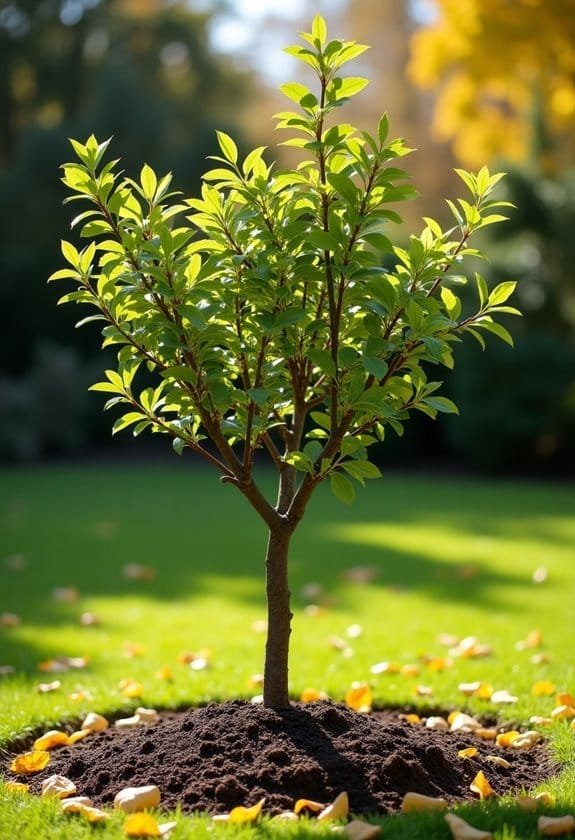The crab apple (Malus sylvestris) is a wild ancestor of cultivated apples, thriving in European woodlands and reaching heights of 14 meters. It's distinguished by its small, tart fruits measuring 2-5 cm in diameter and glossy, oval-shaped leaves up to 6 cm long. This resilient tree plays an important ecological role, supporting over 90 insect species and providing essential food for wildlife through its May blossoms and autumn fruits. It prefers well-drained, moist soils with a pH of 6.0-7.0 and requires full sunlight for ideal growth. The species' rich genetic heritage and ecological significance offer fascinating insights into the evolution of modern apple varieties.
Main Points
- Malus sylvestris is a wild apple species growing up to 14 meters tall, producing small tart fruits and serving as ancestor to cultivated apples.
- The tree displays pink-white blossoms in May, attracting vital pollinators like bees and supporting up to 93 different insect species.
- Crab apples thrive in well-drained, moist soils with full sunlight exposure and can adapt to various soil types from clay to sandy loam.
- Small fruits measure 2-5 centimeters in diameter, changing from yellow-green to red, providing essential food for wildlife throughout growing seasons.
- Regular pruning, proper spacing, and monitoring for diseases like apple scab and fireblight are crucial for maintaining tree health.
Introduction

The Malus sylvestris, commonly known as the crab apple or wild apple, stands as a significant deciduous tree species native to European and Asian landscapes.
Growing up to 14 meters in height, this remarkable member of the Rosaceae family produces small, tart fruits that measure approximately 3 centimeters in diameter.
The crab apple's ecological importance extends beyond its physical characteristics, as it serves as a critical food source for wildlife and supports dozens of insect species, making it a cornerstone species in its native habitats.
Common Name
Known widely across Europe, Malus sylvestris carries the common name "crab apple" or "European crab apple," reflecting its distinctive small, tart fruits that measure 2-5 cm in diameter. This common name serves to distinguish it from cultivated apple varieties, which typically produce larger, sweeter fruits.
The origins of the term "crab apple" are deeply rooted in the fruit's astringent characteristics, with the name emphasizing its wild nature in contrast to domesticated apple varieties.
While the species was previously classified under the scientific name M. pumila, this designation has since been superseded by its current nomenclature, Malus sylvestris.
The common name has transcended mere botanical classification, embedding itself in cultural narratives and traditional practices throughout European history.
In ancient Celtic traditions
Scientific Name
Scientifically classified as Malus sylvestris, the European crab apple belongs to the diverse Rosaceae family, sharing genetic lineage with pears and cherries. This taxonomic classification reflects its distinct characteristics as a deciduous species that has evolved in the temperate regions of Europe and Asia.
The scientific name Malus sylvestris distinguishes this wild variety from its cultivated relatives, emphasizing its natural, undomesticated status in the botanical world.
While the European crabapple produces relatively small fruits, typically measuring 3 centimeters in diameter, its genetic significance extends far beyond its diminutive size.
Recent genetic studies have revealed that Malus sylvestris has made substantial contributions to the genetic makeup of modern cultivated apples, though it isn't considered their
Overview
While scientific classification provides formal identification, crab apples stand as remarkable members of Europe's native flora, representing a significant cornerstone in the evolutionary history of modern fruit cultivation.
These resilient trees, reaching heights of up to 10 meters, showcase nature's architectural prowess through their rounded canopies and adaptive characteristics.
Malus sylvestris serves as the wild ancestor of the domesticated apple, contributing valuable genetic material that has shaped contemporary apple varieties.
The species displays its versatility by thriving in diverse habitats, from woodland edges to hedgerows across Europe and extending into Turkey.
Its ecological significance extends beyond mere survival, as the tree produces small, vibrant fruits that shift from yellow-green to red during maturation, measuring 2-4 centimeters in diameter.
These tart pomes play an essential role in supporting local wildlife populations, offering sustenance to birds and mammals throughout their growing season.
The tree's blossoms attract important pollinators, creating a harmonious relationship between flora and fauna that exemplifies the interconnected nature of forest ecosystems.
Key Features
The crab apple presents a striking silhouette in woodland settings, reaching heights of up to 10 meters with its characteristic rounded crown and gnarled, spine-covered branches.
During springtime, the tree bursts into life with fragrant white-pink blossoms that eventually transform into small, spherical fruits measuring 2-4 centimeters in diameter.
Its glossy, oval-shaped leaves extend up to 6 centimeters in length, featuring distinctive rounded teeth and downy tips that make the tree a valuable resource for various lepidopteran species.
Growth Size
Throughout its growth cycle, crab apple trees develop into medium-sized specimens reaching heights of up to 10 meters (32 feet), characterized by their rounded shape and expansive canopy. As mature trees grow, they establish a distinctive silhouette in the landscape, with their gnarled branches extending outward to create a well-balanced, rounded shape that provides substantial shade and visual interest.
The tree's architectural development continues over its impressive 80-to-100-year lifespan, during which it maintains a robust structure while adapting to various environmental conditions. Its branches, often adorned with protective spines, create an intricate network that supports the tree's seasonal displays of foliage and flowers.
The crown expansion accommodates the annual emergence of glossy, oval leaves measuring up to 6 centimeters in length, which contribute to the tree's overall symmetrical form. This measured growth pattern allows the crab apple to serve as an excellent specimen tree, offering enough height to create visual impact while remaining manageable in both urban and rural settings.
During spring, the tree's size provides a prime framework for displaying its characteristic white-pink blossoms, which later transform into small, ornamental fruits.
Appearance
Standing as a proof of nature's artistry, crab apple trees display an array of distinctive features that make them instantly recognizable. The tree's exterior showcases a greyish-brown bark that twists and contorts into intricate patterns, creating a natural sculpture that draws the eye upward through its gnarled surface.
The tree's appearance transforms dramatically through the seasons, beginning with its oval-shaped leaves that measure up to 6 centimeters in length. These glossy green foils feature rounded teeth along their edges and possess downy tips on their undersides, adding texture to the tree's visual profile.
During spring, the crab apple bursts into life with delicate white-pink blossoms that perfume the air with their sweet fragrance.
Perhaps most striking are the fruits themselves, which emerge as small yellow-green spheres measuring 2-4 centimeters in diameter. These diminutive apples display distinctive ribbing across their surface and undergo a remarkable transformation as they mature, their hues shifting from yellow-green to vibrant red, creating a spectacular display against the tree's canopy.
Flowering Season
When spring shifts into early summer, crab apple trees burst into spectacular bloom during their May flowering season. The trees produce an abundance of delicate flowers, each measuring 2-3 centimeters in diameter, which cluster together to create a stunning visual display.
These fragrant blossoms, ranging from pristine white to soft pink, transform the entire tree into a living bouquet that captivates both human observers and important pollinators.
The flowering phase represents a significant period in the tree's annual cycle, serving as an important resource for early-season insects, particularly bees.
Each hermaphrodite flower presents a perfect arrangement of reproductive structures, featuring five distinctive petals that act as natural landing platforms for visiting pollinators.
This carefully orchestrated display isn't merely for aesthetic purposes; it's an important mechanism for ensuring successful reproduction.
Growing Requirements

Crab apple trees flourish in well-drained, moist soils and require full sun exposure, though they demonstrate remarkable adaptability to partial shade conditions.
Their versatile nature allows them to thrive in various soil compositions, from heavy clay to sandy loam, making them suitable for diverse garden environments and natural landscapes.
These resilient trees need consistent moisture during their establishment phase, but once mature, they can withstand moderate temperature fluctuations and brief periods of drought while maintaining their robust growth pattern.
Light
Like most fruit-bearing trees, Malus sylvestris demands full sunlight to achieve ideal growth and fruit production. The species exhibits its most vigorous growth pattern and highest fruit yield when positioned in locations that receive unobstructed sunlight throughout the growing season, particularly when paired with well-drained soil conditions.
While crab apples can tolerate partial shade, this accommodation comes at a considerable cost to their overall performance. Reduced light exposure markedly diminishes their flowering capacity and subsequently affects fruit development, much like a solar-powered engine running on diminished energy.
For best results, these trees should be situated in open areas where they're free from the shadowing effects of larger, competing vegetation.
The relationship between light exposure and soil drainage plays a vital role in the tree's success. When planted in sunny locations with proper soil conditions, crab apples develop robust canopies and establish strong root systems.
Gardeners should carefully consider positioning these trees where they'll receive maximum sunlight exposure, avoiding areas where buildings or other landscape features might cast persistent shadows.
Soil
Successful cultivation of Malus sylvestris depends heavily on soil conditions, with the species showing a strong preference for heavy, moist, and well-drained soils.
These soil characteristics guarantee ideal nutrient availability and support healthy growth.
Water
Proper water management plays an essential role in growing healthy crab apple trees. The species requires a delicate balance of moisture, thriving in well-drained soils that maintain consistent hydration without becoming waterlogged.
Root systems are particularly susceptible to damage from excessive water accumulation, which can lead to devastating root rot conditions.
Young Malus sylvestris specimens demand special attention to their irrigation needs, especially during their significant establishment phase in the first few growing seasons.
While mature trees demonstrate impressive drought tolerance, they still benefit from supplemental watering during extended dry periods to guarantee ideal fruit development and overall vitality.
The relationship between water availability and successful growth becomes particularly evident in the tree's response to environmental conditions, where proper moisture levels can meaningfully influence both vegetative growth and fruit production.
Monitoring soil moisture remains essential throughout the tree's life cycle, as consistent moisture levels support healthy development without creating saturated conditions that could compromise root health.
In partially shaded locations, careful attention to watering practices becomes even more important, as reduced sunlight can affect the soil's natural moisture retention patterns.
Temperature
While thriving in temperate climates, crab apple trees require specific temperature conditions for ideal growth and fruit production. These resilient trees flourish in growing season temperatures between 15°C to 25°C (59°F to 77°F), which provides the perfect environment for robust leaf development and fruit formation.
Crab apples demonstrate remarkable cold tolerance, as they're hardy to USDA Zones 4 to 8, enabling them to withstand winter temperatures plummeting to -30°C (-22°F). However, young trees and spring blossoms need protection from unexpected frost, which can damage delicate flower buds and compromise the season's fruit yield.
Like natural solar collectors, these trees require a minimum of 6 hours of direct sunlight daily to maintain their growth cycle and guarantee abundant fruiting.
The soil temperature plays an essential role in the tree's overall health, with ideal root development occurring when soil temperatures remain between 10°C to 20°C (50°F to 68°F). This temperature range promotes efficient nutrient absorption and supports the complex network of feeder roots that sustain the tree throughout its growing cycle.
Pollinator Criteria
Malus sylvestris stands out as a crucial pollinator hub, with its nectar-rich flowers attracting an impressive array of beneficial insects, particularly bees.
The tree's strategic flowering period in May aligns perfectly with peak pollinator activity, while its hermaphrodite blooms facilitate effective cross-pollination among different specimens.
Research has documented that crab apple trees can support up to 93 insect species in Britain, making them essential contributors to both local biodiversity and the successful pollination of nearby commercial apple orchards.
Attracted Pollinators
The sweet fragrance of crab apple blossoms actively draws a diverse array of pollinators, especially bees, during the peak flowering season in May. These remarkable trees serve as crucial pollination partners, providing both abundant nectar and high-quality pollen to support local insect populations.
The hermaphroditic nature of Malus sylvestris flowers guarantees a consistent and reliable source of nutritional resources for visiting pollinators, particularly during the critical spring emergence period. This timing proves especially beneficial for bee species, which depend on early-season flowering plants to establish and maintain their colonies.
Research has demonstrated that crab apple trees play an important role in enhancing pollinator diversity within their surrounding ecosystems. Their presence creates a ripple effect throughout local habitats, strengthening the pollination networks that sustain numerous plant species in woodlands and hedgerows.
The increased pollinator activity around these trees contributes considerably to the overall ecological resilience of the area, making Malus sylvestris an important cornerstone species for maintaining biodiversity and supporting healthy ecosystem functions.
Pollination Method
During the peak of spring flowering, bees emerge as the primary pollinators of crab apple trees, drawn in by their nectar-rich blossoms and distinctive sweet fragrance. These industrious insects serve as essential pollination partners for cultivated apple orchards and wild crab apple populations alike, guaranteeing successful reproduction throughout their native ranges.
The unique hermaphroditic nature of crab apple flowers, containing both male and female reproductive structures within each blossom, allows for self-pollination when necessary. However, cross-pollination facilitated by bees greatly enhances fruit production and genetic diversity within populations.
The timing of flowering in May coincides perfectly with the emergence of various bee species, creating a mutually beneficial relationship that has evolved over countless generations.
The effectiveness of this pollination system is demonstrated by the remarkable diversity of insect visitors, with British populations alone supporting 93 different species.
This successful pollination strategy culminates in the autumn production of small, 3-centimeter pomes, which provide sustenance for wildlife and guarantee the continuation of this ecologically significant species.
Care & Maintenance

Successful crab apple cultivation begins with selecting a sunny location and well-drained soil, which establishes the foundation for robust growth and abundant flowering.
Regular maintenance includes systematic pruning to enhance air circulation and shape, along with careful monitoring for common issues like apple scab and fireblight that can compromise tree health.
Companion planting with pollinator-friendly perennials and allowing controlled grazing nearby can create a balanced ecosystem that supports the tree's natural regeneration and fruit production cycle.
Planting Tips
Growing crab apple trees requires careful attention to planting location and soil conditions for best results.
When selecting a planting site, gardeners should prioritize well-drained soil with a pH between 6.0 and 7.0, which provides the perfect environment for root.
Ongoing Care
Proper ongoing care determines whether a crab apple tree flourishes or struggles after planting. The most essential maintenance tasks include regular pruning during late winter or early spring, before new growth emerges, to maintain the tree's shape and promote ideal health.
A thorough care regimen requires attention to multiple factors that influence the tree's health. The soil around the tree should remain consistently moist but well-drained, and applying a layer of mulch helps retain moisture while suppressing unwanted weed growth.
Fertilization plays a significant role in sustaining healthy development, particularly during early spring when the tree benefits most from a balanced nutrient application.
Vigilant monitoring for common ailments such as apple scab and fireblight guarantees early detection and treatment. When these issues arise, implementing organic control measures helps protect the tree while maintaining environmental harmony.
The tree's location in full sunlight, combined with proper care, is crucial for its overall health and vitality.
Suggested Companions
Companion planting around crab apple trees creates a natural ecosystem that benefits all species involved. Strategic placement of complementary plants enhances biodiversity while promoting healthier growth patterns throughout the garden space.
Hawthorn and blackthorn serve as excellent companions, as they share similar habitat preferences and contribute to a robust hedgerow ecosystem.
When selecting companions for crab apple trees, careful consideration must be given to spacing requirements, as these majestic trees can reach heights of 10 meters with substantial canopy spread. The integration of wildflowers and native grasses at the tree's base attracts essential pollinators during the May flowering period, ensuring successful fruit development.
These ground-level companions also help prevent soil erosion and maintain moisture levels.
Proper maintenance of both crab apple trees and their companions involves regular pruning to maintain ideal air circulation and prevent fungal issues. A thick layer of mulch around the base creates a protective barrier that
Are Bird Cherry Trees Similar to Crab Apple Trees in Their Ecological Benefits?
Both the bird cherry tree and crab apple tree offer rich ecological benefits by supporting wildlife. The bird cherry tree attracts pollinators like bees and butterflies with its fragrant blossoms, while crab apple trees provide food for birds and mammals. Together, they enhance biodiversity and contribute to a thriving, balanced ecosystem.
Common Issues
The European crab apple faces several significant threats from both fungal and bacterial pathogens that can devastate entire populations of trees.
Among the most problematic are apple scab, which causes dark lesions on leaves and fruit, and the aggressive fireblight bacteria that creates a characteristic scorched appearance in branches and twigs.
While proper maintenance and early detection can help manage these issues, the increasing hybridization with domestic apple varieties makes wild populations more vulnerable to diseases that traditionally affected cultivated trees.
Pests/Diseases
Maintaining healthy crab apple trees requires vigilance against several common diseases that can threaten their essentiality. Among the most prevalent challenges is apple scab, caused by Venturia inaequalis, which manifests as olive-green spots on leaves and can trigger premature defoliation, weakening the tree's overall health.
The destructive honey fungus, Armillaria mellea, poses a particularly severe threat by attacking the root system, eventually leading to the tree's demise, especially in specimens already compromised by environmental stress.
Equally concerning is fireblight, a bacterial infection caused by Erwinia amylovora, which creates a distinctive scorched appearance on blossoms and young shoots, potentially spreading like wildfire to nearby apple varieties.
Powdery mildew, characterized by its telltale white coating on foliage, can greatly diminish the tree's vigor and aesthetic appeal.
To combat these pests and diseases effectively, gardeners must implement regular monitoring routines and proper management strategies, including strategic pruning and meticulous sanitation practices, which form the cornerstone of maintaining robust crab apple specimens in both ornamental and naturalized settings.
Solutions
Successful crabapple cultivation depends on implementing targeted solutions for common issues that plague these ornamental trees. Conservation efforts focus on maintaining genetic diversity through strategic planting of pure Malus sylvestris specimens in areas where they won't face competition from domestic varieties.
Traditional livestock grazing practices play a crucial role in seed dispersal and population maintenance, while protection from modern forestry methods helps preserve the tree's natural habitats in fragmented woodlands.
Land managers must carefully monitor for prevalent diseases like apple scab and fireblight, implementing thorough management strategies that protect both wild and cultivated specimens.
Community engagement serves as a cornerstone of effective conservation, with educational initiatives raising awareness about the ecological significance of these native trees.
Local involvement in sustainable land-use practices guarantees the long-term survival of crabapple populations, while targeted habitat protection measures help maintain the delicate balance of woodland ecosystems.
Summary

Crab apple trees stand as remarkable specimens of European flora, reaching heights of up to 10 meters with their distinctive rounded crowns and gnarled branches.
Malus sylvestris represents a crucial link in Europe's botanical heritage, producing


